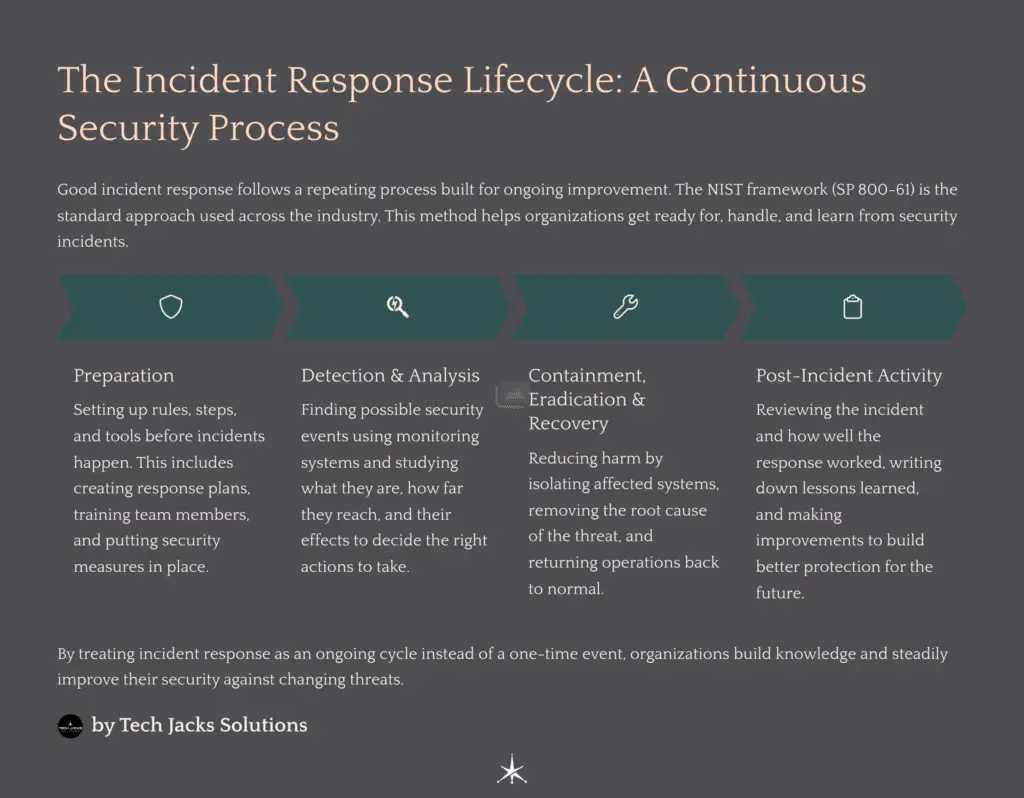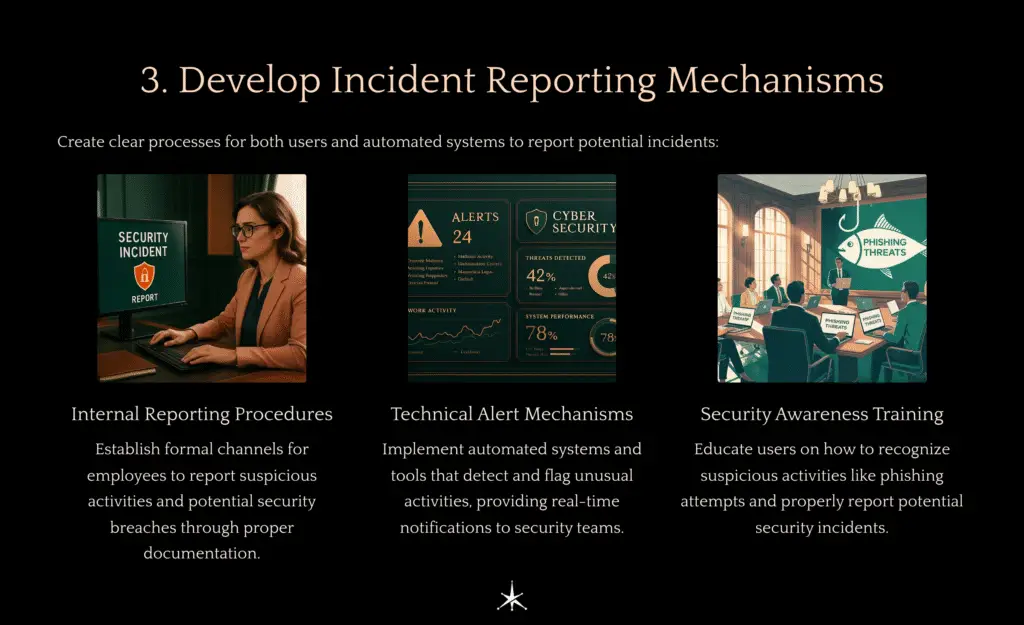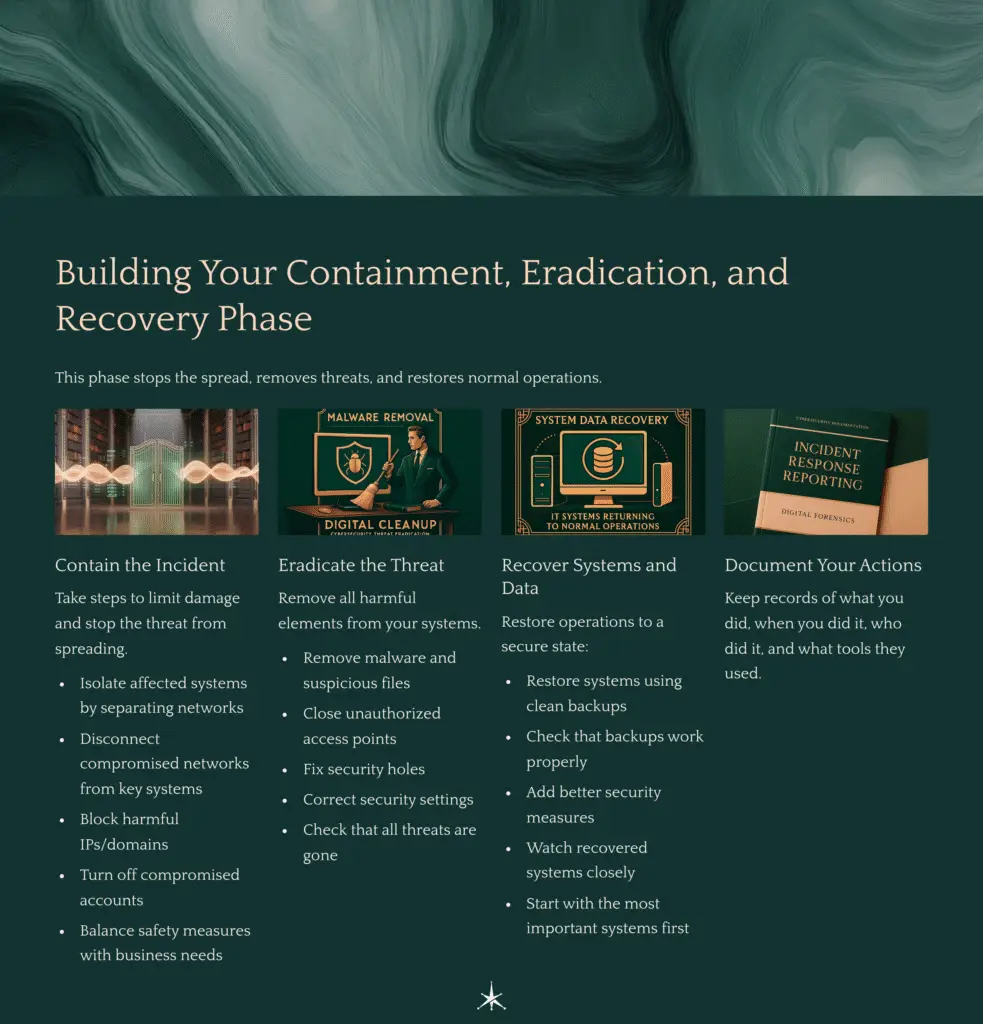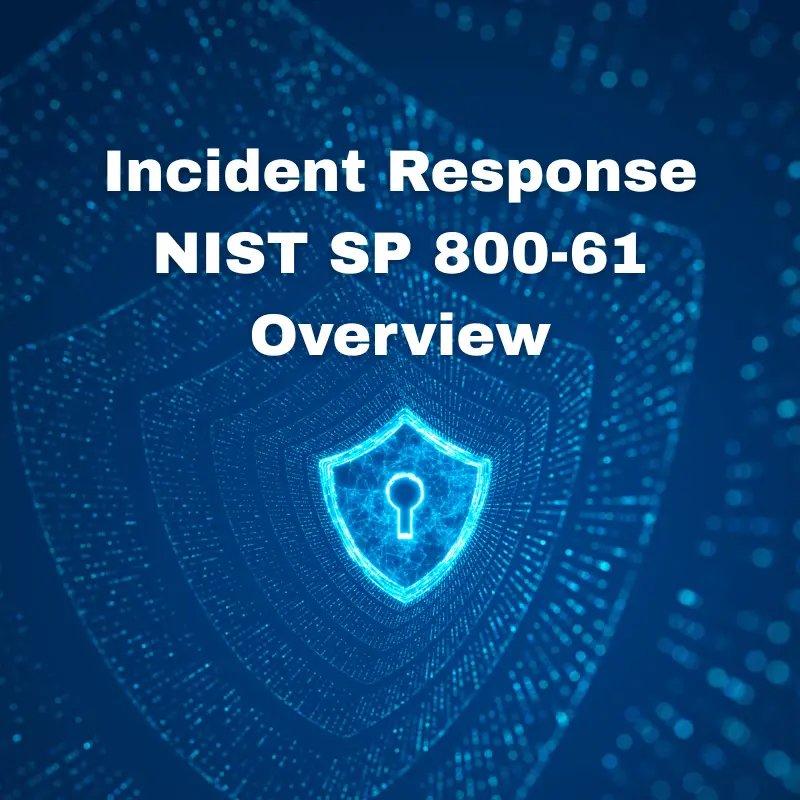The Thing That Keeps You up at Night
It’s 2:47 AM, and the first signs of trouble start to surface. Unusual network traffic begins streaming from your financial database server, but no one is there to catch the alerts. At this moment, a sophisticated ransomware attack is quietly taking hold of your organization’s network. What happens next? That depends entirely on one thing: whether you have an incident response plan in place.
If there’s one hard truth about today’s cybersecurity landscape, it’s this: the question isn’t if your organization will face a security incident, it’s when. And yet, so many businesses operate without a clear plan. The result? Chaotic responses, longer recovery times, and consequences that can feel overwhelming, even devastating.
So how do you prepare for the inevitable? This guide is here to help. Together, we’ll walk through the process of building an incident response program step by step. Along the way, we’ll follow two parallel stories of the same ransomware attack:
- Scenario A: An organization caught off guard without a plan – Mess Around and Find Out Inc (MAAFO Inc)
- Scenario B: A team with a structured incident response framework in place – Tech Jacks Solutions (TJS LLC)
Think of this as more than just a guide, it’s a conversation about why preparation matters and how it can completely change the outcome of a security incident. By the end, you’ll have a clear roadmap for creating your own plan and a deeper understanding of why this investment in preparation is one of the most crucial decisions your organization can make.
Understanding the Incident Response Lifecycle
Incident response isn’t a one-time event but rather a cyclical process of continuous improvement. The most widely accepted approach follows the National Institute of Standards and Technology (NIST) framework outlined in Special Publication 800-61, which divides incident response into four key phases:
- Preparation – Actions taken before an incident occurs
- Detection and Analysis – Identifying and understanding security events
- Containment, Eradication, and Recovery – Stopping the incident, removing its cause, and restoring systems
- Post-Incident Activity – Reviewing what happened and improving future responses
This cycle creates a feedback loop where each incident strengthens your organization’s resilience against future threats. Let’s explore each phase in detail, contrasting how our scenarios unfold at each stage.

Phase 1: Preparation – Building Your Foundation
The Scenario: Before the Attack
Scenario A (No Plan): At MAAFO Inc, cybersecurity is viewed as an IT problem. They have basic antivirus software and a firewall, but no documented incident response plan. The IT team is small and overworked, focusing mainly on keeping systems running. Nobody has been assigned specific incident response responsibilities, and there are no playbooks for common threats. Most employees have never received security awareness training.
Scenario B (With Plan): At TJS LLC, leadership recognized the increasing threat landscape and invested in building incident response capabilities. They’ve developed a comprehensive Incident Response Plan, established a cross-functional team with clear roles, created detection mechanisms, acquired necessary tools, trained their personnel, and developed basic playbooks for common scenarios like ransomware attacks.
Building Your Preparation Phase
The Preparation phase is the foundation of effective incident response. Here’s what you need to establish:
1. Develop an Incident Response Plan (IRP)
Your Incident Response Plan serves as the foundational document for your entire program. It should outline:
- Program goals – What you aim to achieve through incident response
- Incident definitions – Clear criteria for what constitutes a reportable incident
- Communication plan – Who needs to be informed (both internally and externally), how communication will occur, and backup methods if primary channels are compromised
- Incident classification and prioritization – Framework for categorizing incidents by severity and determining response priorities
2. Establish an Incident Response Team (IRT)
Having designated individuals with clearly defined roles prevents confusion and delays when urgent action is needed. Your IRT structure should include:
- Team composition – Designated individuals responsible for incident handling
- Roles and responsibilities – Clearly defined duties, potentially using a RACI matrix (Responsible, Accountable, Consulted, Informed)
- Contact information – Comprehensive list of team members and external resources
- Escalation procedures – When and how to involve senior leadership or specialized help
3. Develop Incident Reporting Mechanisms
Create clear processes for both users and automated systems to report potential incidents:
- Internal reporting procedures for employees
- Technical alert mechanisms
- User training on recognizing and reporting suspicious activities

4. Obtain Necessary Tools and Resources
Ensure access to essential capabilities:
- System, application, and network logs
- Security monitoring tools
- Basic forensic capabilities
- Secure communication channels
5. Conduct Initial Training and Awareness
Prepare both your response team and general users:
- Train response personnel on the IRP, communication protocols, and their specific roles
- Educate all employees on how to identify and report potential security incidents
- Practice incident classification and prioritization with your team
6. Develop Basic Playbooks/Runbooks
Create step-by-step guidance for common incident types like ransomware or phishing attacks. These playbooks should include:
- Prerequisites and initial assessment steps
- Communication templates and requirements
- Specific actions across all response phases
7. Ensure Responders Have Necessary Access
Define and implement procedures for quickly obtaining required access levels during an incident.
8. Establish a Learning Framework
Plan for post-incident reviews that will help your organization learn and improve after each event.
Phase 2: Detection and Analysis – Identifying the Threat
The Scenario: Initial Signs of Compromise
Scenario A (No Plan): At MAAFO Inc, the ransomware infection begins late Thursday night. A security tool generates some alerts, but nobody sees them until the next morning. By the time an IT administrator checks his email at 8:45 AM, multiple systems are already encrypted. With no incident classification framework, the admin isn’t sure if this is a major incident or just an isolated issue. He starts investigating on his own while also trying to handle routine morning tickets, losing critical time.
Scenario B (With Plan): At TJS LLC, their security monitoring system detects the unusual network traffic at 2:54 AM and automatically triggers an alert to the on-call incident responder. The responder uses the company’s playbook to quickly confirm this is a potential ransomware attack. By 3:15 AM, she has classified it as a Severity 1 incident based on their classification framework and initiated their ransomware response protocol, which includes automatically notifying the core incident response team.
Building Your Detection and Analysis Phase
The Detection and Analysis phase focuses on identifying potential security events and determining their nature and impact.
1. Monitor Systems for Security Events
Ensure logging is properly enabled and regularly review alerts from your monitoring tools:
- Establish 24/7 monitoring capabilities (either in-house or outsourced)
- Configure alerts for known indicators of compromise
- Develop baseline understanding of normal network behavior
2. Analyze Detected Events
When notifications occur:
- Investigate to confirm whether a valid security incident has occurred
- Determine the scope and systems affected
- Identify potential impact on data and business processes
- Establish likely cause using logs and forensic techniques
3. Categorize and Prioritize the Incident
Apply your predefined severity and prioritization framework to determine how urgently the incident needs to be addressed and what resources should be allocated:
- Severity 1: Critical impact, requiring immediate full team response
- Severity 2: Significant impact, requiring prompt attention
- Severity 3: Moderate impact, requiring attention within standard timeframes
- Severity 4: Low impact, to be handled as part of normal operations
4. Document Findings
Record key information about:
- Initial detection method
- Systems and data involved
- Observations and indicators
- Analysis actions taken
Phase 3: Containment, Eradication, and Recovery – Taking Action
The Scenario: Responding to the Attack
Scenario A (No Plan): By noon at MAAFO Inc, the situation has deteriorated significantly. Over 60% of their servers and 40% of workstations are encrypted. The ransomware has spread to their backup server, corrupting recent backups. The CEO is demanding answers, but there’s confusion about who should communicate what to whom. Some IT staff are trying to restore systems, while others are still trying to understand what happened. An employee finds a ransom note demanding $500,000 in cryptocurrency. No one has a documented procedure for this situation, and panic is setting in.
Scenario B (With Plan): At TJS LLC, by 3:30 AM, their incident response team has activated their ransomware playbook. The security lead immediately isolates affected network segments to prevent lateral movement. By 4:15 AM, they’ve identified patient zero and the initial infection vector—a phishing email. By 6:00 AM, they’ve contained the malware to just three non-critical servers. The communication lead has briefed executives using their pre-approved communication templates, and the legal team is reviewing notification requirements. Backup integrity has been verified, and the recovery process has begun following their documented procedures.
Building Your Containment, Eradication, and Recovery Phase
This critical phase involves stopping the incident from spreading, removing its cause, and restoring normal operations.
1. Contain the Incident
When responding to a security incident, it’s critical to act quickly to prevent further spread or damage. Begin by implementing strategies outlined in your incident response playbooks:
- Isolate affected systems: Immediately disconnect any compromised devices from the network to prevent the threat from spreading to other systems.
- Disconnect network segments if necessary: If the scope of the attack is unclear, consider segmenting parts of the network to limit potential exposure.
- Block malicious IP addresses or domains: Use your firewall or other security tools to block known suspicious IPs or domains associated with the attack.
- Disable compromised accounts: Temporarily suspend access to accounts that may have been breached to prevent unauthorized actions.
- Balance containment with business needs: Make containment decisions carefully, weighing the security risks against the potential business impact to ensure minimal disruption while maintaining safety.
Each step should be carried out methodically while documenting actions to ensure a full understanding of the incident.
2. Eradicate the Threat
To ensure your system is secure, it’s crucial to eliminate the root cause of the attack and clean up any artifacts left behind. This step involves:
- Deleting malware and any suspicious or harmful files that may have been introduced into the system.
- Removing unauthorized access methods, such as backdoors or rogue accounts, to block the attacker from re-entering.
- Patching vulnerabilities that the attacker exploited, such as outdated software or unpatched systems, to close security gaps.
- Correcting misconfigurations that may have made your system vulnerable in the first place, like improper permissions or open ports.
- Conducting thorough verification to ensure the threat has been completely eliminated and no traces of the attack remain.
This step is essential to prevent a recurrence and restore the integrity of your system.
3. Recover Affected Systems and Data
Restore normal business operations following a cybersecurity incident by taking these key steps:
- Restore systems from clean backups: Use backups that are confirmed to be free of any malicious code to reestablish system functionality.
- Verify backup integrity: Before restoring, ensure the backups are fully intact and uncorrupted to avoid reinfection or data loss.
- Implement additional security controls: Strengthen your system by adding updated security measures, such as firewall adjustments, patch updates, or enhanced endpoint protection.
- Monitor recovered systems closely: Continuously track the performance and activity of restored systems to ensure there are no residual threats or vulnerabilities.
- Prioritize recovery based on business criticality: Focus first on systems and data that are essential to critical business functions, ensuring minimal disruption to operations.
These steps not only help in restoring operations but also reduce the risk of a recurrence.
4. Document Actions Taken
Maintain detailed and accurate records of all containment, eradication, and recovery steps taken during the process, including specific actions performed, tools used, and the individuals or teams involved. Ensure each entry is timestamped to create a clear timeline of events that can be used for analysis, reporting, and improving future response efforts.

Phase 4: Post-Incident Activity – Learning and Improving
The Scenario: Aftermath and Lessons Learned
Scenario A (No Plan): Three weeks after the attack, MAAFO Inc has finally restored most systems, though some data was permanently lost. The total cost of the incident exceeded $2 million, including the $500,000 ransom they ultimately paid, business downtime, emergency IT consultant fees, and lost customers. The CEO demands that “this never happen again,” but with no formal review process, the organization makes only superficial changes. Six months later, they experience another significant security incident.
Scenario B (With Plan): At TJS LLC, all systems were restored within 36 hours, with no ransom paid and minimal data loss. One week after the incident, they conduct a formal post-incident review with all stakeholders. They identify that the phishing email bypassed their filters due to a misconfiguration and that two servers were vulnerable because of missing patches. They document these findings and create specific action items with assigned owners. Three months later, when a similar attack targets their industry, TJS LLC improved defenses prevent any impact.
Building Your Post-Incident Activity Phase
The final phase is where continuous improvement happens, transforming each incident into an opportunity for growth.
1. Conduct a Post-Incident Review/Analysis
Hold meetings with relevant stakeholders to:
- Analyze the incident timeline
- Evaluate the effectiveness of your response
- Determine root cause
- Identify areas for improvement in detection, diagnosis, and mitigation
- Discuss what went well and what could have been better
2. Identify Lessons Learned and Action Items
Document specific insights and create a concrete list of improvements:
- Updates needed for the IRP
- Playbook revisions
- New control requirements
- Training opportunities
- Technology gaps
3. Implement Improvements
Assign ownership to action items and ensure their completion:
- Update documentation
- Enhance procedures
- Improve training materials
- Add new detection mechanisms
- Strengthen preventive controls
4. Document the Incident in a Final Report
Create a formal record summarizing:
- Incident details and timeline
- Impact assessment
- Actions taken during each phase
- Lessons learned and improvements made
- Recommendations for preventing similar incidents
Putting It All Together: Your 30-Day Incident Response Readiness Plan
The Scenario: Six Months Later
Scenario A (No Plan): At MAAFO Inc, despite their painful experience, they’ve made little systematic progress in building incident response capabilities. They purchased some additional security tools, but without proper procedures and training, these investments provide minimal value. When they face another attack, they’ll likely experience the same chaos and significant losses.
Scenario B (With Plan): Beyond addressing the specific issues from the incident, TJS LLC uses it as momentum to further strengthen their program. They conduct quarterly tabletop exercises to practice their response, regularly update their playbooks with new threat information, and continuously train both their response team and general employees. Their security posture improves with each cycle of their incident response process.
Your 30-Day Implementation Plan
Now that we’ve covered the incident response lifecycle in detail and seen how it plays out in real scenarios, let’s break down how you can implement these principles in just 30 days:
Week 1: Initial Assessment and Planning
- Day 1-2: Conduct a gap analysis of current incident response capabilities
- Day 3-5: Draft initial Incident Response Plan
- Day 6-7: Identify potential team members and define roles
Week 2: Team Formation and Basic Documentation
- Day 8-10: Finalize team structure and obtain necessary commitments
- Day 11-12: Create incident classification framework
- Day 13-14: Develop communication templates and protocols
Week 3: Tool Acquisition and Initial Training
- Day 15-17: Inventory available tools and identify gaps
- Day 18-19: Develop and deliver basic training for team members
- Day 20-21: Create initial playbooks for two most common incident types
Week 4: Testing and Refinement
- Day 22-24: Conduct tabletop exercise to test the plan
- Day 25-26: Refine documentation based on exercise findings
- Day 27-28: Train general users on incident reporting
- Day 29-30: Finalize access procedures and documentation
Conclusion: A Tale of Two Outcomes
We’ve followed two organizations through the same ransomware attack with dramatically different outcomes:
MAAFO Inc faced weeks of disruption, permanent data loss, reputational damage, and costs exceeding $2 million—all because they lacked a structured incident response capability.
TJS LLC contained the same attack within hours, restored operations in less than two days, paid no ransom, and emerged stronger than before—all because they had invested in preparation before the crisis hit.
The difference wasn’t luck or even technology: it was preparation and process.
Building an effective incident response capability doesn’t happen overnight, but even organizations with limited resources can dramatically improve their security posture by following the four-phase cycle:
- Preparation – Building the foundation before incidents occur
- Detection and Analysis – Quickly identifying and understanding threats
- Containment, Eradication, and Recovery – Taking effective action to resolve incidents
- Post-Incident Activity – Learning and improving from each experience
Remember that incident response is a journey of continuous improvement. Start with the basics outlined in our 30-day plan, and gradually enhance your capabilities as your organization’s security maturity grows.
The most important step is simply to begin…before you find yourself in the middle of Scenario A, wishing you had prepared for Scenario B.

